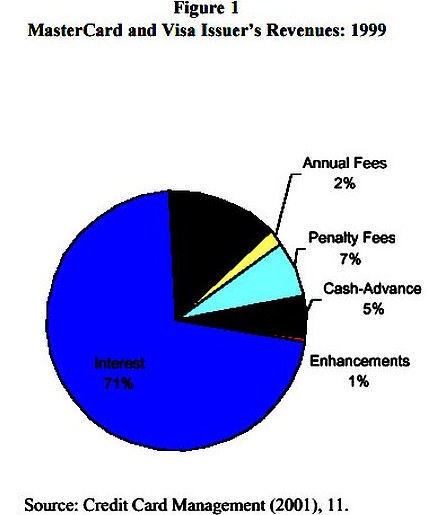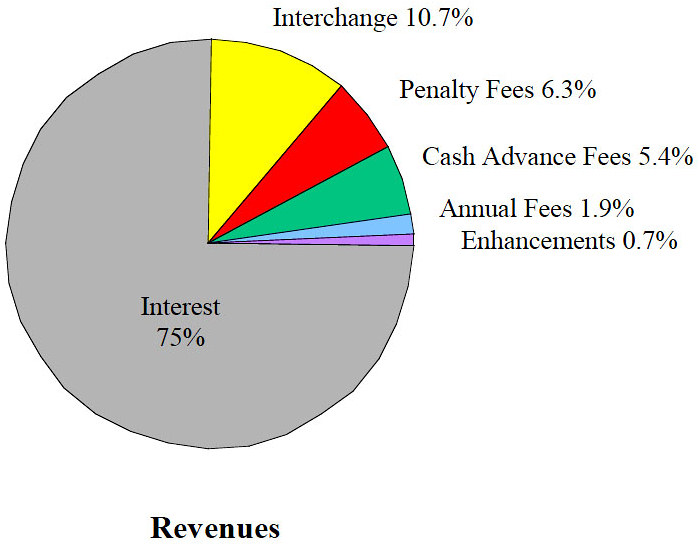Interest And Penalty Fees Revenue
or
Interest And Penalty Fees
means
Credit Card
Issuers
under
Four-Party
Schemes
and
Three-Party Schemes
derive a material amount
of their annual
Interest And Fees Revenue
from -
*
Credit Cardholder Fees;
and
*
Interest Income.
The primary components of
Credit
Cardholder Fees
are -
*
Cash Advance Fees
*
Late Payment Fees
*
Overlimit Fees
There were 13,161,440 credit cards in Australia as of June 2022,
netting a
national debt accruing interest of $18.2 billion.
"RateCity.com.au estimates
Australia’s total credit card interest bill for January 2022 was $257 million.
This is based on a balance accruing interest of $17.39bil @ RBA estimated
average credit card rate of 17.38 per cent."
It is likely that the RBA's average credit card rate is the ave. Credit Card
Purchase
Interest Rate. However, 20% of this $257 million indebtedness
could be on Cash Advances paying 5% or
higher interest rates.
The RBA publishes a veritable welter of
financial statistics on many financial instruments. Relying on RBA Excel
file c01hist.xlsx Philip Johnston
created adjoining worksheets 'CreditCardsSummayData'
and 'KeyCreditCardStats'.
He estimates that aggregate interest levied on Credit Cards in Australia upon
Revolvers during the year ended 30 Sept 2022 was $3.889 billion
circa based on an average interest rate of 21.5%.
Latitude Financial's 'Go MasterCard' had a Cash
Advance interest rate of
29.49%
until March 2019.
Presently it is 25.9%,
but now incorporates a Cash Advance Fee of $3 or 3% of the cash advance amount,
whichever is greater = 28.9%. It also charges an explicit 'Late fee' of $35 and
$8.95 monthly account service fee when outstanding balance is greater than $10.
Little wonder that
Credit Cardholders
with low
Financial Literacy Capacity (independently classified by the Productivity Commission, ABS
and ASIC) get lured into applying for a
Latitude Financial GO
Mastercard because of deceptively offering
'Enjoy now. Pay later. Interest Free'.
The
80 - 20 Rule (Pareto
Principle) almost applies to
Credit
Card Issuers' primary revenue source as 33% of Credit Cardholders, known
as
Revolvers, pay 100% of
Interest And
Penalty Fees Revenue.
The other 67%,
known as
Transactors,
enjoy a Free Ride with their
Lines of Credit, where they buy now and
pay later.
Until
the ABA's 'Banking Code of Practice'
(implement by 1 July 2019),
Interest Income was
materially boosted due to the practice of Credit Card Issuers -
(A) charging Interest
often at
Usurious
Unsecured Interest Rates
on
the entire
Closing Balance for the previous
month if the previous month's Purchases were unpaid by the
Payment Due Date
- even paid a day late or a dollar short;
and
(B)
Withdrawing the
Interest Free Period on Purchases for up to the
subsequent two months - hence three months' interest is charged from the date of
each
Purchase
for up to three consecutive months
upon not paying the entire
Closing Balance
for the previous month by the
Payment Due Date as evidenced in
-
*
Example
1
-
Unconscionable
Conduct - St George Visa Card;
and
*
Example 2
- Unconscionable Conduct - Coles 'No Annual
Fee MasterCard' and
Coles 'Rewards
MasterCard'
The
User Pays Principle which is applies
in over 95% of the range/scope of financial transactions in Australia (eg. filling up the tank with
petrol, going to the movies, buying a case of beer, paying the electricity bill,
catching the bus to work, paying the rent or mortgage repayment) is non-existent
when enjoying a
Line Of Credit with a
Credit Card/s. As evidenced below, Net
Interchange Fee
income is immaterial to the P&L of a
Credit
Card Issuers.
The above 'pie chart' (on RHS) appears in a journal report titled
"Who Pays for Credit Cards?"
dated 2001 which displays a break-up of Card Issuers' Revenues for the
aggregate of Visa, MasterCard and Discover cards in the USA. It shows
that net U.S. Interest Revenues of 75% and associated Penalty Fees Revenue (Late
Payment Fees and
Overlimit Fees)
of 6.3% and Cash Advance Fees of 5.4% aggregate to 86.7% of U.S. Card Issuers' Annual Revenue.
Interchange Fees charged to the Merchant are only 10.7%.
The following statement is from the Reserve Bank's
Submission
to the Senate Inquiry into Matters Relating to Credit Card Interest Rates - August 2015
“The tendency for interchange rates to rise to high levels is most apparent in
unregulated jurisdictions like the United States where credit card interchange
rates in the MasterCard system are as high as 3.25 per cent plus 10 cents,
implying that – after scheme fees and acquirer margin – some merchants may pay
over 3½ per cent in merchant service fees for high rewards cards.”
So in Australia, where the RBA has materially pegged
Interchange Fees (see quote immediately below), the percentage of
Net Revenue from Interest and Late Payment
Fees is likely to also exceed 80% of Total Net Revenues.
“What
are the RBA's new interchange standards?
The weighted-average benchmarks will remain the primary element of interchange
regulation. The weighted-average benchmark for credit cards will remains at
0.50 per cent. The weighted-average benchmark for debit cards will be lowered
from 12 cents to 8 cents, effective 1 July 2017,consistent with the fall in
average transaction values since the debit benchmark was introduced.
The weighted-average benchmarks will be supplemented by caps on any individual
interchange fee within a scheme's schedule. No credit card interchange fee will
be permitted to exceed 0.80 per cent and no debit interchange fee will be able
to exceed 15 cents if levied as a fixed amount or 0.20 per cent if levied as a
percentage amount.”
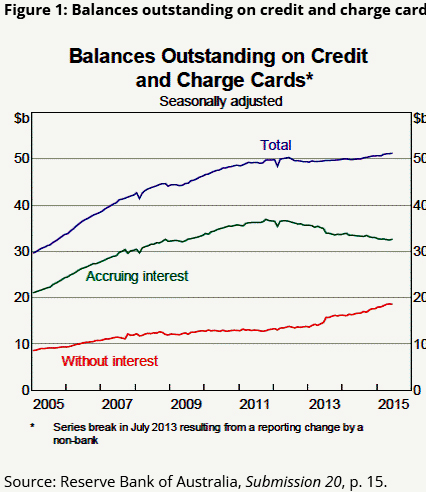 |
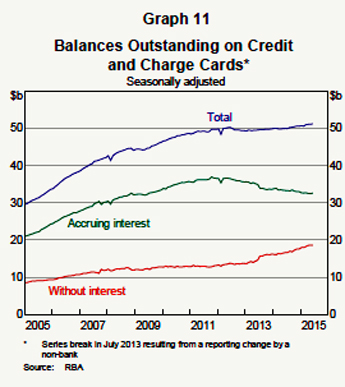 |
2.9 While the RBA advised that about 75 to 80 per cent of credit
card transactions do not accrue interest, about 65 per cent of the
total quantum of credit card debt (or, as noted above, $33.1
billion) is accruing interest. To clarify,
interest paying
cardholders 'account for about 30–40 per cent of accounts, about
20–25 per cent of transactions, but close to two-thirds of the
outstanding stock of debt'.9
2.10 The RBA observed that the proportion of credit card debt
balances accruing interest has fallen from around 75 per cent to 65
per cent since 2012. Balances accruing interest have also fallen in
absolute terms since peaking in late 2011 (as shown in Figure 1
above).
The RBA suggested the decline 'possibly reflects a range of factors
such as changes in consumers' financial behaviour, government
reforms that took effect in 2012 relating to repayments and limit
increase arrangements, and possibly also the effect of competition
for balance-transfer offers'.10 Similarly, the CBA suggested the
trend might be attributed to 'higher customer repayment rates and
aggressive zero per cent balance transfer offers'.11
2.12 While the use of credit cards grew strongly through the 1990s
and early 2000s, since 2004–05 spending on debit cards has grown
more strongly than on credit cards.13 The RBA suggested that this
trend: …is likely mostly a reflection of broader macroeconomic
trends, as the period to the mid-2000s was one where the ratio of
household debt (especially for housing) to income grew significantly
and where the household saving rate was falling. By contrast, the
period since the mid�2000s has seen a broad stabilisation in the
household debt ratio, a recovery in the saving rate and more
conservative trends in card use and debt.14 2.13 The ABA pointed to
similar trends in how Australians were using their credit cards. It
noted that while the overall value of credit card transactions is
currently growing at around 4 to 5 per cent a year, over the past
decade repayments on credit cards, excluding interest, have exceeded
new transactions: Over the year ending May 2015, repayments exceeded
the value of transactions by $8 billion; the value of transactions
on credit cards was $293 billion and repayments were $301 billion.15
2.14 Whereas the RBA referred to recent declines in the amount of
credit card debt accruing interest and the proportion of credit card
debt to overall household debt, a joint submission from the
Financial Rights Legal Centre and Consumer Action Law Centre
highlighted higher levels of credit card indebtedness in the past
decade: Australian credit card debt is continuing to grow rapidly,
in line with a huge growth in household debt. The majority of
Australian households now have a net credit card debt. Statistics
released by the Reserve Bank of Australia show that as at May 2015
there were 16 million credit cards with outstanding balances of
$51.2 billion. Almost 64% of outstanding balances, or $32.6 billion,
was accruing interest. This represents an incredible 47.3% increase
in balances accruing interest over the past 10 years. These
statistics correspond with the huge increase in household debt.
Since March 1977, we have seen the percentage of household debt to
disposable income increase from nearly 40% to over 140%.16
'Revolvers' and 'Transactors' 2.15 Industry and regulatory analysts
commonly categorise cardholders as 'Revolvers' and 'Transactors'.
Revolvers typically pay interest on their balances (as they carry
forward, or 'revolve', card balances over time), whereas Transactors
typically pay off their balance in full and thereby avoid paying
interest on their balances. According to the RBA, revolvers are more
likely to hold lower-rate cards than Transactors, and Transactors
are more likely to hold higher-rate rewards cards.17 2.16 The RBA
advised that the proportion of revolvers is higher among low income
households and when high-income households do fall into the revolver
category, they are more likely to be 'occasional revolvers' as
opposed to 'persistent revolvers'.18 2.17 Drawing on data from the
household, income and labour dynamics survey in Australia (HILDA),
Treasury also noted that low-income households have more credit card
debt relative to their incomes and pay more in credit card interest
relative to their incomes than high-income households (although
higher income households pay more interest in absolute terms). HILDA
data similarly shows that low net worth households pay higher
proportions of interest relative to their income.19 Summarising the
data in its submission, Treasury advised that low income households:
…would be more likely to be paying the high interest rates charged
on credit cards and be more likely to be subject to high additional
fees and charges. In particular, they will be more affected by the
practice of backdating interest charges when cardholders fail to pay
off their full balance at the end of each billing cycle.20 2.18 The
committee also received evidence suggesting that people on low
incomes, including many disadvantaged and vulnerable people, are
more likely to use credit cards for cash advances.21 In addition to
generally being subject to specific fees, cash advances are not
eligible for any interest free period and typically attract an even
higher rate of interest than the ongoing purchase rate on a credit
card. 2.19 The RBA's 2013 Consumer Use Survey showed that 73 per
cent of cardholders participating in the survey typically pay off
their account in full within the interest free period, implying that
27 per cent typically do not. Industry estimates suggest the
proportion of cardholders who typically pay interest is slightly
higher, at between 30 and 40 per cent. The RBA ventured that the gap
between its survey results and industry data may reflect hoped-for,
rather than actual behaviour on the part of consumers. 22 2.20 A
similar point was made in a joint submission by the Consumer Action
Law Centre and Financial Rights Legal Centre. They referred to a
recent ANZ financial literacy survey which found that 65 per cent of
cardholders claimed they had always paid their main card balance in
full over the last 12 months: However, the proportion of credit card
balances accruing interest indicates this figure is overly
optimistic. A significant number of consumers are actually
'revolvers': consumers who pay minimum monthly repayments or a
fraction of the outstanding balance and incur high interest rate
charges— around two thirds of outstanding balances actually attract
interest. This tendency towards identifying oneself as a transactor,
when in fact you are a revolver, is a basic behavioural bias.
Consumers tend to underestimate or are blind to factors that can
impede repayment of their credit card balances. People are overly
optimistic and have other biases in assessing risk, meaning they are
overconfident when it comes to estimating the amount of debt they
will incur.23 |
Each month, cardholders receive
statements of their use of credit for transactions over the previous
month. For a cardholder who has paid off their previous balance in
full, credit cards typically offer an interest-free period of up to
55 days on new transactions, given that the cardholder typically has
about 25 days following the end of the statement period to repay the
statement balance. If the balance is not paid off in full, interest
becomes due from the date of each transaction (and the cardholder
will not benefit from an interest-free period the following month).
In the June quarter of 2015, new credit card transactions
averaged around $24 billion per month. At the end of June, the total
level of credit card debt was $51.5 billion (Graph 11). Of this
amount, $33.1 billion, or around 65 per cent was bearing interest. A
simple calculation would suggest that around 75-80 per cent of
transactions on credit cards do not accrue interest. That is,
interest-paying ‘revolvers’ account for about 30-40 per cent of
accounts, about 20-25 per cent of transactions, but close to
two-thirds of the outstanding stock of debt.9
The proportion of the stock of debt that accrues interest has
fallen from around three-quarters of balances in 2012. Balances
accruing interest have also fallen in absolute terms after peaking
in late 2011 (Graph 11). This decline possibly reflects a range of
factors such as changes in consumers’ financial behaviour,
government reforms in 2012 relating to repayments and limit increase
arrangements, and possibly also the effect of competition for
balance-transfer offers.
9 The Bank does not have data on the distribution of
account balances. However, the average balance across all 16 million
accounts is around $3 200. On the assumption that around 30 to 40
per cent of all accounts accrue interest, the average balance
outstanding on those accounts would be around $5 000 to $7 000, and
the implied average balance for those accounts that do not accrue
interest would be around $1 600 to $1 900.
More broadly, credit card debt has represented a declining share
of household borrowing over the past decade. Credit card debt peaked
as a share of household debt at around 4½ per cent in 2001 but now
represents a little below 3 per cent of household debt. While the
ratio of overall household debt to income has been relatively steady
over the past decade, the ratio of credit card debt to household
income has declined (Graph 12). The decreased share of credit card
debt may partly reflect the high cost of credit cards relative to
mortgage interest rates and the increasing ability of households to
use mortgage offset and redraw facilities as a source of low-cost
funds. These products have become increasingly common over the past
decade or two, with most loans now including such a facility (see
RBA (2015b)). The amount available under these facilities has grown
from less than 10 per cent of household income in early 2008 to over
20 per cent of household income (or around $220 billion) in mid
2015.
|
Significantly in the USA,
the annual
Report to the Congress
on the Profitability of Credit Card Operations of Depository Institutions - June 2016
includes the below Table 2 which shows that US
Credit Card Issuers in 2015 had Net Interest Income of 8.73% and total non-Interest
income of -1.94% of average quarterly assets.
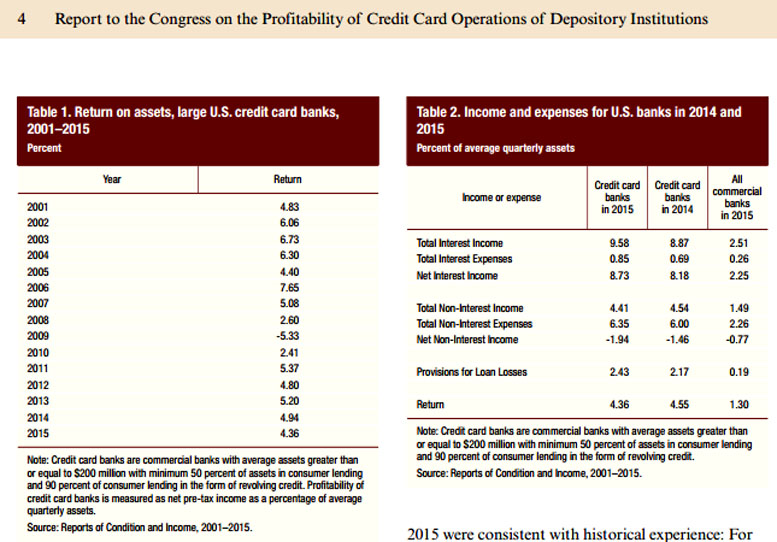
2.9 While
the RBA advised that about 75 to 80 per
cent of credit card transactions do not accrue interest,
about 65 per cent of the total quantum of credit card debt (or, as noted above,
$33.1 billion) is accruing interest. To clarify, interest paying cardholders
'account for about 30–40 per cent of accounts, about 20–25 per cent of
transactions, but close to two-thirds of the outstanding stock of debt'.9
2.10 The RBA observed that the proportion of credit card debt balances
accruing interest has fallen from around 75 per cent to 65 per cent since 2012.
Balances accruing interest have also fallen in absolute terms since peaking in
late 2011 (as shown in Figure 1). The RBA suggested the decline 'possibly
reflects a range of factors such as changes in consumers' financial behaviour,
government reforms that took effect in 2012 relating to repayments and limit
increase arrangements, and possibly also the effect of competition for
balance-transfer offers'.
10
Similarly, the CBA suggested the trend might be attributed to 'higher customer
repayment rates and aggressive zero per cent balance transfer offers'.11
Interest Rates - RBA
Credit Cardholders' Contribution To Credit
Card Issuers
Gross Revenue
Interest rates on
Credit Card debt

